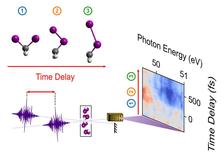Sketch of the all-XUV pump-probe time-resolved measurement of the molecular structural dynamics of the diiodomethane molecule at FLASH (Figure: © MPIK Heidelberg).
A large international collaboration of scientists from the Max-Planck Institute for Nuclear Physics (MPIK) in Heidelberg, DESY, Heidelberg University, University of Münster and many others demonstrated for the first time an all-XUV (extreme ultraviolet) time-resolved absorption spectroscopy investigation of a small molecule: the photoinduced structural dynamics of diiodomethane. By means of the short wavelength of XUV laser pulses, individual atoms in the molecule can be addressed specifically via a well-defined electronic excitation.
The team, headed by Christian Ott from the division of Thomas Pfeifer at the MPIK, performed the experiment at the FLASH beamline BL2 at DESY. Two identical XUV pulses with a variable time delay interact subsequently with an iodine atom of CH2I2. The excitation during the first pulse triggers the dissociation of the molecule, which includes a structural deformation through a short-lived isomeric state (see sketches ①②③ in the figure).
This, in turn, changes the XUV absorption behaviour of CH2I2 which can be analysed via time-dependent spectroscopy with the second XUV pulse. The change in the absorption signal (red: enhancement, blue: reduction) is clearly visible at a delay of about 200 femtoseconds (fs). This time-resolved information on the transition through the corresponding transient molecular structure ② was extracted by the comparison of experimental spectra with theoretical calculations from the group of Alexander Kuleff (Heidelberg University).
Overall, this is a key step towards using free-electron lasers for time-resolved measurements of moving atoms in molecules, the so-called “molecular movie”. In the future, even larger bandwidths and multi-colour modes will be available to excite and sample different electronic transitions with "local" atom-specific spectroscopic resolution. Moreover, it also lights the way forward to ultimately control the molecular structure on the fundamental atomic and electronic level.
(from MPIK news)
Original publication: All-XUV pump-probe transient absorption spectroscopy of the structural molecular dynamics of di-iodomethane, M. Rebholz, T. Ding, V. Despré, L. Aufleger, M. Hartmann, K. Meyer, V. Stooß, A. Magunia, D. Wachs, P. Birk, Y. Mi, G. Dimitrova Borisova, C. da Costa Castanheira, P. Rupprecht, G. Schmid, K. Schnorr, C. D. Schröter, R. Moshammer, Z.-H. Loh, A. R. Attar, S. R. Leone, T. Gaumnitz, H. J. Wörner, S. Roling, M. Butz, H. Zacharias, S. Düsterer, R. Treusch, G. Brenner, J. Vester, A. I. Kuleff, C. Ott and T. Pfeifer, Phys. Rev. X (2021). DOI: 10.1103/PhysRevX.11.031001







